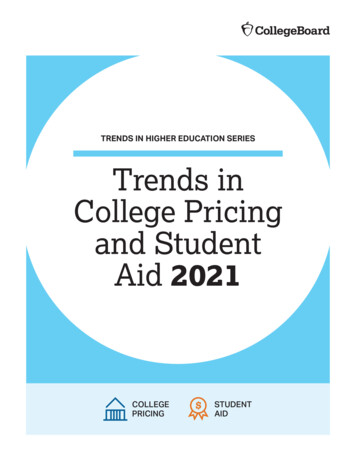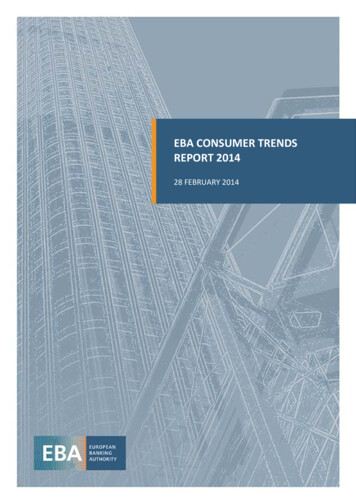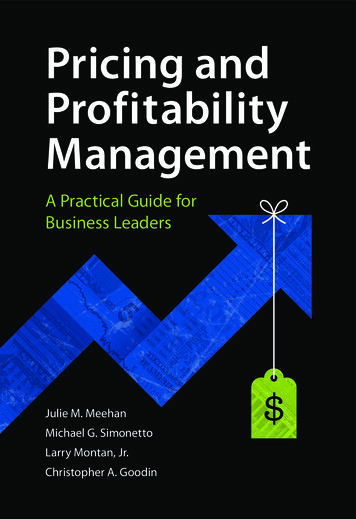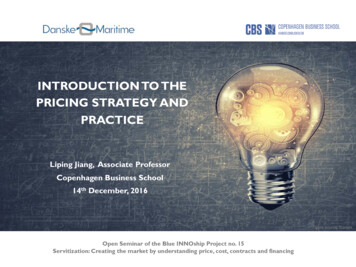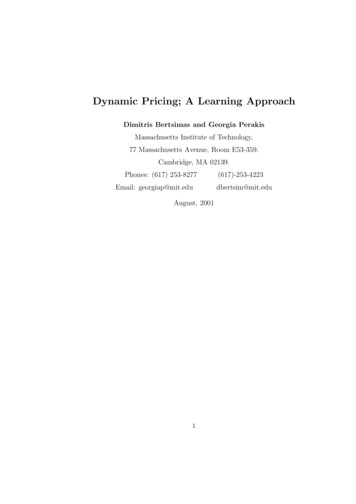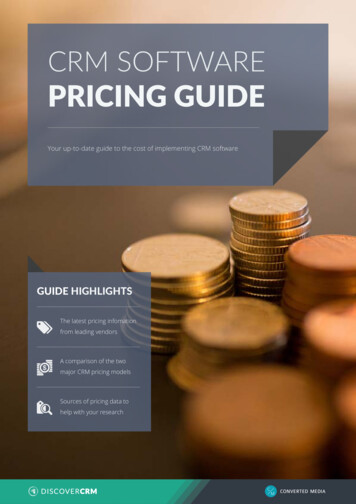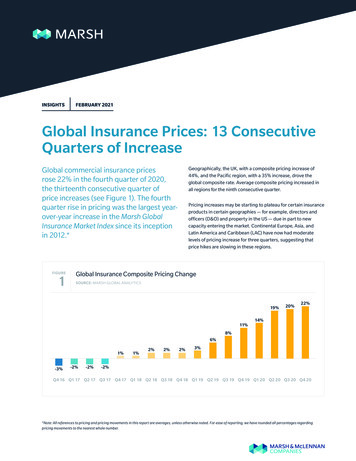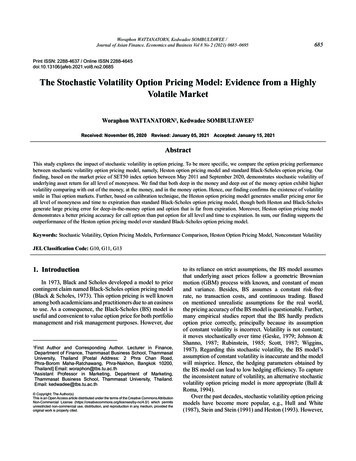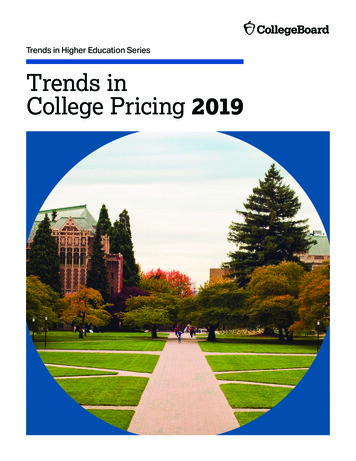
Transcription
Trends in Higher Education SeriesTrends inCollege Pricing 2019
See the Trends in Higher Education website at research.collegeboard.org/trendsfor figures and tables in this report and for more information and data.About College BoardCollege Board is a mission-driven not-for-profit organization that connectsstudents to college success and opportunity. Founded in 1900, College Boardwas created to expand access to higher education. Today, the membershipassociation is made up of over 6,000 of the world’s leading educational institutionsand is dedicated to promoting excellence and equity in education. Each year,College Board helps more than seven million students prepare for a successfultransition to college through programs and services in college readiness andcollege success—including the SAT and the Advanced Placement Program .The organization also serves the education community through research andadvocacy on behalf of students, educators, and schools. For further information,visit www.collegeboard.org.Trends in Higher EducationThe Trends in Higher Education publications include the annual Trends in CollegePricing and Trends in Student Aid reports and the Education Pays series, along withother research reports and topical analysis briefs. These reports are designed toprovide a foundation of evidence to strengthen policy discussions and decisions.The tables supporting all of the graphs in this report, a PDF version of the report, anda PowerPoint file containing individual slides for all of the graphs are available onour website research.collegeboard.org/trends.Please feel free to cite or reproduce the data in this report for noncommercial purposes with proper attribution.For inquiries or requesting hard copies, please contact: trends@collegeboard.org. 2019 College Board. College Board, Advanced Placement Program, SAT, and the acorn logo are registeredtrademarks of College Board. All other marks are the property of their respective owners.Visit College Board on the web: collegeboard.org.01469-962November 2019
HighlightsFrom 2001-02 through 2012-13, annual increases in publishedtuition and fees exceeding 5% (or exceeding the overall rate ofinflation by more than 2 or 3 percentage points) were common.Beginning in 2013-14, however, the rate of increase in publishedprices slowed considerably at public two-year and four-year andprivate nonprofit four-year institutions.At public four-year institutions, the smaller price increases combinedwith increases in institutional and state grant aid slowed the growthof the average net price students pay in recent years. In the privatenonprofit four-year sector, where institutional grants are the dominantsource of aid and price increases have been more consistent over themore recent decade, the average net price fell over the first half ofthe decade, but rose by about 800 between 2014-15 and 2019-20.PUBLISHED TUITION AND FEES AND ROOMAND BOARDAverage published in‐state tuition and fees in the publicfour‐year sector increased by 230 (2.3% before adjustingfor inflation), from 10,210 in 2018-19 to 10,440 in 2019-20.Average total tuition and fee and room and board charges in2019-20 are 21,950. (Table 1) Average published out-of-state tuition and fees at public four-VARIATION IN TUITION AND FEESThe median published tuition and fee price for full-timestudents attending public or private nonprofit four-yearinstitutions in 2019-20 is 12,710; 25% of these studentsattend institutions with prices below 9,000 and 26%attend institutions charging 30,000 or more. (Figure 2) The average published tuition and fee price at public doctoraluniversities is 27% higher than that at public master’suniversities ( 11,380 vs. 8,990). In the private nonprofit sector,this difference is 46% ( 45,380 vs. 31,140). (Table 1) In 2019-20, average published tuition and fees for in-districtstudents at public two-year colleges range from 1,430 inCalifornia and 1,860 in New Mexico to 7,100 in New Hampshireand 8,210 in Vermont. (Figure 5) In 2019-20, average published tuition and fees for in-statestudents at public four-year institutions range from 5,580 inWyoming and 6,350 in Florida to 16,920 in New Hampshire and 17,470 in Vermont. (Figure 6) The out-of-state price is four and a half times as high as thein-state price at the flagship university in Florida and four timesas high in North Carolina; it is less than 50% higher in NorthDakota and South Dakota. (Figure 7)year institutions rose by 620 (2.4%), from 26,200 in 2018-19to 26,820 in 2019-20. Average total charges in 2019-20 are 38,330. (Table 1) In five states, average published in-state tuition and fees atyear institutions rose by 1,200 (3.4%), from 35,680 in 2018-19to 36,880 in 2019-20. Average total charges in 2019-20 are 49,870. (Table 1)WHAT STUDENTS ACTUALLY PAY Average published tuition and fees at private nonprofit four- Average published in-district tuition and fees at public two-yearcolleges increased by 100 (2.8%), from 3,630 in 2018-19 to 3,730 in 2019-20. (Table 1) Average tuition and fees for full-time students in the for-profitsector were 14,600 in 2018-19. (Table 1)GROWTH IN COLLEGE PRICESBetween 2009-10 and 2019-20, published in-state tuition andfees at public four-year institutions increased at an averagerate of 2.2% per year beyond inflation, compared with 3.9%between 1989-90 and 1999-00 and 5.0% between 1999-00and 2009-10. (Figure 4A) The 2.2% average annual rate of increase in inflation-adjustedtuition and fees in the public four-year sector corresponds to anaverage annual increase of 200 in 2019 dollars, compared with 170 per year from 1989-90 to 1999-00 and 330 per year from1999-00 to 2009-10. (Figure 4A) In the public two-year and private nonprofit four-year sectors,published prices are more than twice as high in inflationadjusted dollars in 2019-20 as they were in 1989-90. Theaverage in-state public four-year tuition and fee price is aboutthree times as high as it was in 1989-90. (Figure 4B)public four-year institutions fell between 2014-15 and 2019-20,after adjusting for inflation. In nine states, the price increasedby 15% or more. (Figure 6)On average, full-time students at public two-year collegesreceive more than enough aid in 2019-20 to cover tuition andfees, but the estimated 400 they have available to put towardother expenses is a decline from almost 1,000 in 2010-11.Out-of-pocket living expenses average 8,600. (Figure 8) Average published tuition and fees at public four-yearinstitutions rose by 590 from 9,850 (in 2019 dollars) in2014-15 to 10,440 in 2019-20. Over these five years, averagenet tuition and fees rose about 400. (Figure 9) In 2015-16, average net tuition and fees at public four-yearcolleges for full-time dependent students from the lowestincome families were 2,340—compared with 11,150 for thosefrom the highest-income families; average other expenses aftergrant aid were 12,210 and 14,640, respectively. (Figure 11) The average net tuition and fees for full-time students at privatenonprofit four-year institutions rose from 13,400 (in 2019dollars) in 2011-12 to 14,400 in 2019-20; the net price remainsbelow its level from 2001-02 through 2008-09. (Figure 10) Between 2003-04 and 2015-16, the average net price fordependent students from low-income families at for-profitinstitutions rose 36%, from 8,830 (in 2015 dollars) to 12,020;the average net price for low-income students in the privatenonprofit sector fell by 2% to 7,580. (Figure 12)3
PUBLIC FUNDINGState and local funding per student rose in 2017-18 (in inflationadjusted dollars) for the sixth consecutive year, followingfour years of decline. Funding per student fell by 23% from 8,610 (in 2017 dollars) in 2007-08 to 6,590 in 2012-13, andthen rose by 19% to 7,850 in 2017-18. (Figure 15B) Between 2007-08 and 2012-13, the combination of a 15% declinein total funding and an 11% increase in enrollment led to a 23%decline in state and local funding per public sector student. Bycontrast, between 2012-13 and 2017-18, a 15% increase in totalfunding and a 3% decline in enrollment led to a 19% increase infunding per student. (Figure 15B)ENROLLMENT PATTERNSTotal postsecondary enrollment fell by 196,000 (1%)between fall 2015 and fall 2017. There were 118,000(2%) more students at public four-year and 60,000 (2%)more at private nonprofit four-year institutions, but127,000 (2%) fewer at public two-year colleges and247,000 (18%) fewer in the for-profit sector. (Figure 21) Graduate students rose from 10% of all students in the for-profitsector in fall 2000 to 15% in 2010 and 23% in 2017. Despite thesharp decline in enrollment in the sector between 2010 and 2017,there were more than twice as many students enrolled in 2017(1.1 million) as in 2000 (450,000). (Figure 21) In 2017-18, state and local funding per student was 9% lower (after Ten percent of black undergraduates attend for-profit In 2017-18, state and local funding for public higher education Total FTE enrollment in public institutions in the United Statesadjusting for inflation) than a decade earlier ( 7,850 vs. 8,610)and 10% lower than in 1987-88 (down from 8,700). (Figure 15B)ranged from 3,070 per full-time equivalent (FTE) student inNew Hampshire and 3,190 in Vermont to 16,940 in Hawaii and 17,700 in Alaska. (Figure 16)INSTITUTIONAL FINANCESBetween 2006-07 and 2016-17, educational expenditures perFTE student increased by 17% in inflation-adjusted dollars atpublic doctoral universities, 18% at master’s universities, 9%at bachelor’s colleges, and 12% at two-year colleges in thepublic sector. (Figure 18) Between 2006-07 and 2016-17, average educational expendituresper FTE student rose by 16% in inflation-adjusted dollars at privatenonprofit doctoral universities, 13% at master’s institutions, and9% at bachelor’s institutions in the sector. (Figure 18) In 2016-17, 46% of educational costs at private nonprofitdoctoral universities and 40% at bachelor’s colleges wassubsidy to students not covered by net tuition revenue. Thesubsidy share was 15% at private nonprofit master’s institutions.(Figure 18) The subsidy portion of educational expenditures declined from61% to 40% at public doctoral universities, from 62% to 46% atmaster’s institutions, from 66% to 56% at bachelor’s colleges,and from 74% to 65% at two-year colleges in the sector between2001-02 and 2016-17. (Figure 18) In 2016-17, per-student revenues from government sources andnet tuition were 27,670 at doctoral, 15,830 at master’s, 14,180at bachelor’s, and 11,700 at associate institutions in the publicsector. (Figure 17) In 2016-17, the 10% of students enrolled in the privatedoctoral universities with the highest endowments per studentbenefited from endowments averaging 1.22 million per FTEstudent. The median endowment per FTE student in this sectorwas 63,500. (Figure 19)4institutions—more than twice the share of any other groupenrolled in that sector. (Figure 23A)increased by 8% between 2007 and 2017—from 9.6 million to10.4 million. Changes across states ranged from declines of 13%in Illinois and 10% in Alaska to increases of 24% in Utah and 26%in Texas. (Figure 22A) Overall, two-year colleges accounted for 42% of the public FTEundergraduate enrollment in 2017. In seven states, this share was50% or more; in eight states, it was less than 25%. (Figure 22B) In 2015-16, 28% of full-time undergraduates lived on campus; asimilar share lived with their parents and 44% lived off campusbut not with parents. (Figure 14)COLLEGE AFFORDABILITYAverage published tuition and fees for in-state studentsattending public four-year colleges rose by 6,850 (in2018 dollars) between 1988 and 2018—53% of theincrease in income ( 13,000) of the middle 20% offamilies and 8% of the increase in income ( 87,930) ofthe 20% of families with the highest incomes. (Page 29) In 2018, the average income of the highest 20% of families was3.3 times that of the middle 20% ( 261,760 vs. 78,970 in 2018dollars). It was 2.6 times as high in 1988. (Figure 20A) In 2018, the 121,060 median income of families headed by afour-year college graduate was more than twice the median forfamilies headed by a high school graduate. (Figure 20B) Tuition and fees constitute 39% of the total budget for in-statestudents living on campus at public four-year institutions and20% of the budget for public two-year college students who payfor off-campus housing. (Figure 1). Taking longer to earn a degree increases the price of college.Of 2015-16 bachelor’s degree recipients, 41% completed theirdegrees within four years of first enrolling in college; 59%finished within five years. (Figure 13)
Contents3 Highlights7 Introduction9 Published Charges by SectorTABLE 1Average Published Undergraduate Charges by Sector and by Carnegie Classification,2018-19 and 2019-20FIGURE 1Average Estimated Undergraduate Budgets, 2019-2012 Published Charges over TimeFIGURE 3Tuition and Fees and Room and Board over Time13 Published Charges over TimeFIGURE 4AAverage Rates of Growth of Published Charges by DecadeTABLE 3Tuition and Fees and Room and Board over Time (Unweighted)and by Carnegie Classification,2018-19 and 2019-2010 Student Budgets, 2019-2011 Variation in Tuition and Fees,2019-2014 Tuition and Fees by State:Public Two-YearFIGURE 2TABLE 2FIGURE 4BFIGURE 5TABLE 515 Tuition and Fees by State:FIGURE 616 Tuition and Fees by State:FIGURE 7Public Four-YearFlagship UniversitiesDistribution of Full-Time Four-Year Undergraduates by Tuition and Fees, 2019-20Tuition and Fees and Room and Board over TimePublished Tuition and Fees Relative to 1989-90, by Sector2019-20 In-District Tuition and Fees at Public Two-Year Institutions by State and Five-YearPercentage ChangesTuition and Fees by Sector and State over Time2019-20 Tuition and Fees at Public Four-Year Institutions by State and Five-YearPercentage Changes2019-20 Tuition and Fees at Flagship Universities and Five-Year Percentage ChangesTABLE 6Tuition and Fees at Flagship Universities over Time17 Average Net Price:FIGURE 8Average Net Price over Time for Full-Time Students at Public Two-Year Institutions18 Average Net Price:FIGURE 9Average Net Price over Time for Full-Time Students at Public Four-Year Institutions19 Average Net Price:FIGURE 1020 Net Price by Income:FIGURE 11Average Net Price over Time for Full-Time Students at Private Nonprofit Four-YearInstitutions21 Net Price by Income:FIGURE 12Public Two-YearPublic Four-YearPrivate Nonprofit Four-YearPublic InstitutionsPrivate InstitutionsTABLE 7FIGURE 2018 11FIGURE 2018 1222 Time to DegreeFIGURE 1323 Living ArrangementsFIGURE 1424 Institutional Revenues:State and Local FundingFIGURE 15AFIGURE 15BAverage Net Price over Time for Full-Time Students, by SectorAverage Net Price and Grant Aid by Income and Dependency Status over Time:Public InstitutionsAverage Net Price and Grant Aid by Income and Dependency Status over Time:Private InstitutionsDistribution of Full-Time Undergraduate Students by Net Tuition and FeesTime Elapsed Between Initial College Enrollment and Completion of Bachelor’s Degree:2015-16 Bachelor’s Degree RecipientsLiving Arrangements of Full-Time Undergraduates, 2015-16Annual Percentage Change in State and Local Funding and Public Tuition and Feesover TimeTotal and Per-Student State and Local Funding and Public Enrollment over Time25 Institutional Revenues:FIGURE 1626 Institutional Revenues:FIGURE 17Institutional Revenues per Student at Public Institutions over Time27 Institutional Revenues andFIGURE 18Net Tuition Revenues, Subsidies, and Education Expenditures per Student over TimeState and Local FundingPublic InstitutionsExpendituresState and Local Funding per Student and per 1,000 in Personal Income by State, 2017-18Figures and tables that are only available online at research.collegeboard.org/trends.5
Contents—Continued28 Endowments29 Family IncomeFIGURE 19Endowment Assets per Student, 2016-17FIGURE 20BFamily Income by Selected Characteristics, 2018FIGURE 20AChanges in Family Income over Time30 Enrollment Patterns Over TimeFIGURE 21FIGURE 22ATen-Year Percentage Change in Total Public Enrollment by State32 Enrollment by Race/EthnicityFIGURE 23ADistribution of Undergraduates by Sector within Race/Ethnicity Groups, Fall 201733 Faculty and StaffFIGURE 24A31 Public Enrollment by State34 Notes and SourcesFIGURE 22BFIGURE 23BFIGURE 24BEnrollment by Level of Enrollment and Attendance Status over TimePercentage of All Public Enrollment in Two-Year Colleges by State, 2017Distribution of Undergraduates by Race/Ethnicity Within Sectors, Fall 2017Share of Faculty Employed Full Time over TimeFemale Share of Faculty over TimeFigures and tables that are only available online at research.collegeboard.org/trends.6
IntroductionAfter rising at an average rate of 5.0% beyond inflation between1999-00 and 2009-10 and 3.2% per year between 2009-10 and2014-15, average published tuition and fees at public four-yearcolleges and universities rose 1.2% per year between 2014-15 and2019-20. In 2019-20, the increase was 0.5% (2.3% before adjustingfor inflation). Although this news is encouraging, prices have risenrapidly for many years at the same time that household incomeshave grown slowly, inequality has increased, and too many studentsare struggling with repaying student loans.To understand what tuition increases mean for college affordability, it isimportant to focus on net prices after grant aid, in addition to householdincomes and the earnings payoff to college degrees. Despite theslower growth in published prices, the average net price paid by fulltime public four-year college students rose more between 2009-10 and2019-20 than over the preceding decade. Both Pell Grants and federaltax benefits per student declined after rapid growth in 2009-10, and theincrease in institutional grant aid was not large enough to compensate.But most of this increase in net price was in the early part of the decade.Over the most recent five years, increases in grant aid covered about30% of the relatively small increase in tuition and fees.At public two-year colleges, where about a quarter of full-timeundergraduates are enrolled, more than half of the grant aid comesfrom the Pell Grant program. Declines in that aid combined with priceincreases have led to the average student having about 400 in grantaid available for books, supplies, and living expenses after coveringtuition and fees in 2019-20—a decline from almost 1,000 in 2010-11.In the private nonprofit four-year sector, where price increases havebeen much steadier over the decade, average net price was lower in2014-15 than in 2009-10 but has risen since.As this report documents, income inequality has been increasingfor decades. The dollar increase in the average income of thetop 5% of families between 1988 and 2018 was more than twiceas large as the average income for the middle quintile of familiesand nine times as large as the average income of the lowest fifthof families in 2018. Given this reality, understanding how familiespay for college requires separate analyses for families in differentfinancial circumstances.In addition to information on tuition and fees and family incomes,Trends in College Pricing 2019 provides detailed data about roomand board and other nontuition expenses in student budgets,variation in prices and their rates of change across states andinstitution types, and the length of time students take to completetheir degrees. Although the report does not include analysis ofthe causes of changes in tuition prices, it does include informationthat can provide insight into the forces underlying increases in theprices students pay for college. Potentially relevant factors includechanges in enrollments and state funding levels, the compositionof institutional revenues and expenditures, and the distribution ofendowment resources across institutions.PUBLISHED PRICES FOR ONE YEAROF FULL-TIME STUDYThe prices reported in Trends in College Pricing are for one year offull-time study. Many students enroll part time and prorating theseprices does not always give an accurate picture of the publishedprices that students face, much less of the net prices generated bythe grant assistance and tax benefits they receive.Understanding the financial investment needed for a collegeeducation requires a focus on the total price of earning a degree,not just the price of one year of college. Among students whobegan their studies full time at a four-year institution for the firsttime in 2010, 41% had completed a bachelor’s degree at their firstinstitution after four years and 60% had completed a degree aftersix years (NCES, Digest of Education Statistics 2018, Table 326.10).Similarly, as Trends in College Pricing 2019 documents, 41% of2015-16 bachelor’s degree recipients completed their degreeswithin four years of first enrolling. For 16%, more than 10 yearselapsed before they completed their studies. Although most of thesestudents were not enrolled continuously for so many years, theygenerally paid more tuition, borrowed more, and often sacrificedmore labor market earnings than those who graduated “on time.”The more quickly students earn their degrees, the more time theyhave to earn college-level wages and reap the financial benefits ofpostsecondary education. Bachelor’s degree recipients ages 25to 34 had median earnings 63% ( 19,550) higher than those in thesame age range with high school diplomas in 2018 (U.S. CensusBureau, 2018 Income Data, Table PINC-03).TUITION AND FEES VERSUS TOTAL CHARGESIn addition to tuition and fees, we report room and board charges forresidential students, living costs for commuter students, and othercomponents of student budgets. Trends in College Pricing 2019 alsoincludes information on the living arrangements of college students.In 2015-16, 28% of full-time undergraduates taking courses inclassroom settings lived on campus; a similar share lived with theirparents and 44% lived off campus but not with parents. Whetherstudents live on or off campus, they must pay for housing and food,buy books and supplies, and cover transportation and other basicliving costs. Books and supplies are clearly added costs associatedwith being a student, but many of the other non-tuition expenses aresimilar to those people face when they are not in school.The cost of living poses a significant hurdle for many students.Even those who receive grant aid sufficient to cover tuition andfee charges may struggle to meet living expenses. Although moststudents work at least part time while they are enrolled, forgonewages are the biggest cost for many. Because of the difficulty ofmeasuring this cost, we make no attempt to do so in this report.Since students tend to think of living expenses as part of the cost ofgoing to college, and because they must come up with the funds tocover these outlays, it is useful to use these expenses as a proxy forforgone earnings.7
As is the case each year, Trends in College Pricing 2019 includesestimates of both the average net tuition and fees and the averagenet tuition and fees and room and board full-time students payin the public and private nonprofit sectors after taking grant aidand tax benefits into consideration. On average, grant aid and taxbenefits cover all of the tuition and fees for public two-year collegestudents. Still, the average full-time student in this sector has tocover about 8,600 per year in nontuition expense—an amountthat has increased by about 1,100 since 2011-12. These netexpenses average more than 15,000 for public four-year collegeundergraduates and more than 27,000 for those enrolled in privatenonprofit four-year colleges and universities.The report also includes information on net prices over time forstudents with different family incomes and dependency status atpublic, private nonprofit, and for-profit institutions. These estimates,based on data from the National Postsecondary Student AidStudy (NPSAS), use a different methodology and are not preciselycomparable to the average net prices reported every year in Trends.DISTRIBUTIONAL ISSUESBecause of the variation in tuition and fees and other budgetcomponents, the data in the Trends reports cannot accurately predictthe financial circumstances of individual students. Both averagepublished and net prices by sector and by type of institution, state,or income level conceal considerable variation across students. Forexample, in some states, some public four-year institutions chargemuch more than others. Some institutions offer more grant aid thanothers. The nontuition components of student budgets also differ fromstudent to student, depending partially on their living arrangements.However, as data from the 2016 NPSAS included in this report confirm,students from low-income families pay, on average, much lowernet prices than those from more affluent families. Despite the factthat some student aid at the federal, state, and institutional levels isbased on criteria other than financial circumstances—and despitethe growing share of federal student aid that is not based on financialcircumstances—most aid dollars are distributed at least in part tomeet financial need and provide greater support to students with morelimited resources. Focusing on the distribution of financial aid andthe resulting net prices for different students is critical for assessingbarriers to college access and success. Rising college prices createlarge hurdles for some students, while others are able to finance theireducation without significant hardship.Each year, Trends in College Pricing includes information on thechanging distribution of family incomes. This year we note that in 2018,median incomes for black and Hispanic families were 59% and 62%,respectively, of the median for white families and the median familyincome for families headed by a four-year college graduate was morethan twice the median for families headed by a high school graduate.Average published tuition and fees for in-state students attendingpublic four-year colleges rose by 6,850 (in 2018 dollars) between1988 and 2018—53% of the increase in income ( 13,000) of the8middle 20% of families and 8% of the increase in income ( 87,930) ofthe 20% of families with the highest incomes. These facts highlightthe reality that family background has a significant impact on thechallenges students face financing a college education.INTERPRETING THE DATAMeasuring TuitionA growing number of institutions charge different prices for differentyears of study and/or for different academic majors. In other words,many students on a campus may face published prices quite differentfrom those reported by institutions in College Board’s Annual Surveyof Colleges. Even more fundamental, the lines between sectors areincreasingly blurry as more two-year colleges offer some fouryear degrees. Some states, including Georgia and Wisconsin, havemerged some of their two-year institutions with four-year institutions.Changes like these can have a measurable impact on the averageprices we report by sector, particularly at the state level. For thesereasons, the average published prices for each sector that Trends inCollege Pricing 2019 reports are not precise measures.Trends in College Pricing 2019 presents detailed pricing datafor public two-year and four-year colleges and private nonprofitfour-year colleges and universities. We report average tuition andfees in the for-profit sector from federal data. More informationabout this sector is critical to understanding the circumstances ofstudents enrolled there, who face particular challenges with collegecompletion and student debt.Price ChangesWhile the information reported here provides a best approximationof trends in college charges over time, we caution readers aboutplacing too much reliance on either precise dollar amounts orannual percentage changes. Each year we revise the average pricescalculated the previous year to account for revised data we receivefrom institutions and for changes in enrollment patterns.Details relating to our methodology and data reliability can be foundat the end of the report in Notes and Sources. The tables supportingall of the graphs in the Trends publications, PDF versions of thepublications, PowerPoint files containing individual slides for all of thegraphs, and other detailed data on student aid and college pricing areavailable at research.collegeboard.org/trends. Please feel free to citeor reproduce the data in Trends for noncommercial purposes withproper attribution.
Published Charges by Sector and by CarnegieClassification, 2019-20The average published tuition and fee price for full-time in-state students at public four-year colleges anduniversities is 10,440 in 2019-20, 230 (2.3% before adjusting for inflation) higher than it was in 2018-19.TABLE 1 Average Published Charges (Enrollment-Weighted) for Full-Time Undergraduates, 2018-19 and ofitFour-Year 3,730 10,440 26,820 36,880 100 230 620 1,200Public Four-YearFor-ProfitDoctoralMaster’s— 11,380 8,990— 240 230Carnegie ClassificationPrivate Nonprofit s 8,730 45,380 31,140 36,360 200 1,560 1,070 1,010Tuition and Fees2019-202018-19 Change% Change 3,630 10,2102.8%2.3% 26,200 35,680 14,6003.4%— 11,510 12,990— 11,990 320 380— 3402.4% 11,1402.2% 8,7602.6% 8,5302.3% 43,820 30,0703.6%3.6% 35,3502.9%Room and Board2019-202018-19 Change% Change 8,990 11,510 8,720 11,190 11,1903.1%2.9%2.9% 270 320 12,6103.0%—— 10,580 10,730 14,780 12,240 12,020 460 320 380 11,650 10,290 10,370 14,3202.9%2.8%3.5%3.2% 290 360 11,920 11,6402.7%3.3%Tuition and Fees and Room and Board2019-202018-19 Change% Change 12,720 21,950 38,330 49,870 12,350 21,400 37,390 48,2903.0%2.6%2.5%3.3% 370 550 940 1,580— 23,370 19,570 580 520— 22,790—2.5%— 19,460 60,160 43,380 48,380 19,050
About College Board. College Board is a mission-driven not-for-profit organization that connects students to college success and opportunity. Founded in 1900, College Board was created to expand access to higher education. Today, the membership association is made up of over 6,000 of the world's leading educational institutions
